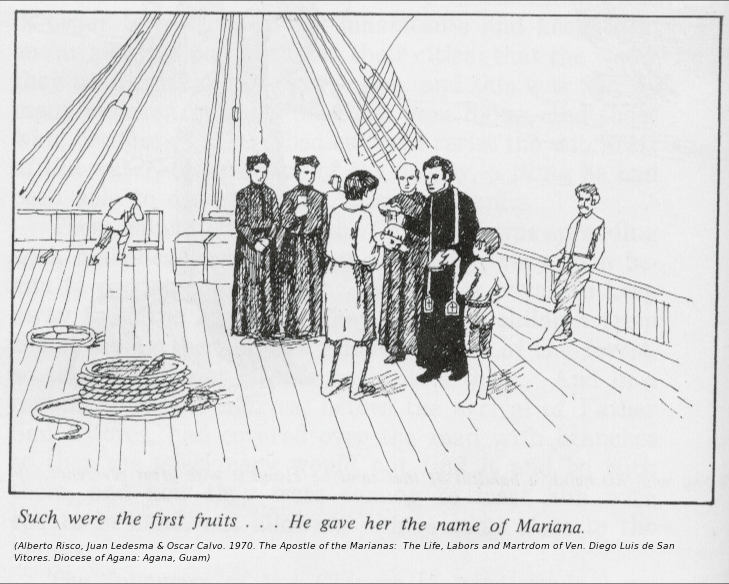One of the earliest known recorded female children of Chamorro ancestry to be baptized and Christianized was named Mariana. Unfortunately, we do who Mariana’s mother was, but appears to be a Chamorro from Saipan. As for her father, that too remains a controversial mystery; however, most historians seem to agree that the Mariana’s father was a survivor of the 1638 Nuestra Senora de la Concepcion Spanish Galleon shipwreck. He brought Mariana aboard the San Diego ship to meet Father San Vitores.
Mariana was described as being about two years old and dressed in white. Mariana was baptized on 16 June 1668 by Father Luis de Morales. This was the following day after the arrival of the San Diego with Father’s San Vitores and Morales.

Pedro What’s His Name
Most historians seem to agree that Mariana’s father was a Filipino Christian named Pedro. However, Father Risco (1970) and those who cite his works, such as Del Valle (1941) indicate that Mariana’s father was a Spaniard named Pedro, who was a shipwrecked survivor of the galleon Concepcion.
Identifying Pedro’s last name is problematic. Perhaps the most controversial issue to resolve is whether or not Pedro is the same Filipino that was killed along with Father San Vitores by Maga’lahi Mata’pang and Hirao in 1672. You see, because the Pedro that was killed in 1672 along with Father San Vitores, is known as Pedro Calungsod (approximately 17 years old) the second Filipino in history to be declared a Saint, when the Vatican canonized him on October 21, 2012.
Spoehr (1951:48) talks about San Vitores’ group making contact with a “Pedro” who was a survivor of the Concepcion. Spoehr (1951:50) also mentions a “Pedro Calangson,” who was San Vitores’ Filipino assistant and killed, but does not indicate if Pedro and Pedro Calangson was the same person.
Rogers (1995:46) states that Marianas father was Pedro Calonsor (also may be known as Casor or Calangsor in some different accounts), who was a Christian Visayan Filipino. In addition, Rogers (1995:55) also indicates that it was Pedro Calansor that was killed along with Father San Vitores by Maga’lahi Matapang and Hirao. Mata’pang hurled a lance that pierced Pedro Calonsor and then Hirao split Pedro’s head with a cantana.
Lugar (1990) also discusses a Pedro Casor and states, “Sanvitores' band, five priests, a lay brother and thirty lay catechists, encountered two survivors of the Concepcion when they landed on Guam in the middle of June 1668, Pedro Casor, a Christian native of the Bisayan region of the Philippines who became a trusted companion of Sanvitores , and Lorenzo, a native of Malabar.” Lugar’s focus was on the Concepcion and therefore did mention the death of Father San Vitores and his assistant.
Tanya Champaco Mendiola’s (2010) writing is the first one I have come across to actually indicate that there were two different Pedro Calungsor’s: one from the 1638 Concepcion shipwreck and a younger one around seventeen years old (aka Pedro Calungsod) that came with Father San Vitores in 1668.
And finally (for now), I am currently reviewing De Viana’s 2004 book. De Viana (2004:48) contends that the Pedro from the 1638 shipwreck and father of Mariana is Pedro Jimenez. His source: Doc. No. 18 of RAH 9/2656, Official report on the life and death of Fr. Medina, letter of Fr. Sanvitores to the Provincial of the Philippines, Agana, 14 May 1671, cited as Document 1671B in HM 5:131-139. Without having reviewed this source I’m not sure what to believe. However, I have noted that in Quimby (2012) he makes an interesting statement that may further support De Viana. Quimby wrote, “Pedro Jiménez, the Concepción beachcomber who had become a favorite of several chiefs on Guam, came aboard the galleon the day after it arrived and reportedly assured the Jesuits that their request to establish a mission would be favorably received.” I will definitely need to get my hands on De Viana’s source that will help to resolve the conflicting historical information as to who may have been Mariana’s father.
[This writing as with my previous posts on Chamorro people I have written about from the 1600's to the 1800’s remains a work in progress.]
References
Francisco Garcia. 2004. The Life and Martyrdom of the Venerable Father Diego Luis de San Vitores , S.J . Translated by Margaret M. Higgins, Felicia Plaza and Juan M.H. Ledesma. Edited by James A. McDonough. MARC Monograph Series 3. Guam: University of Guam
Catherine Lugar. (1990). The History of the Manila Galleon Trade. Sutton, Vermont: Pacific Sea Resources.
Tanya M. Champaco Mendiola, ' Father Diego Luis de San Vitores', referenced March 7, 2013, © 2009 Guampedia™, URL: http://guampedia.com/father-diego-luis-de-san-vitores/
Mathers W, Parker HS, Copus K. 1990. Archaeological Report: The Recovery of the Manila Galleon Nuestra Senora De La Concepcion. Retrieved August 21, 2012 from: http://pacificsearesources.com/html/contents.html
Frank Quimby, ' The Matao Iron Trade Part 3: Appropriation and Entanglement', referenced March 27, 2013, © 2009 Guampedia™, URL: http://guampedia.com/the-matao-iron-trade-part-3-appropriation-and-entanglement/
Alberto Risco, S.J. 1970. The Apostle of the Marianas: The Life, Labors, and Martyrdom of Ven. Diego Luis de San Vitores, 1627-1672. Translated by Juan M.H. Ledesma, S.J. and edited by Msgr. Oscar L. Calvo. Hagåtña: Diocese of Agana
Robert Rogers. 1995. Destiny’s Landfall: A History of Guam. University of Hawaii: Honolulu, HI
John N. Schumacher, S.J. 2001. Blessed Pedro Calungsod, Martyr: An Historian’s Comments on His Philippine Background. Philippine Studies 49(3): 287-336.
Alexander Spoeher. 1954. Saipan – The Ethnology of a War-Devasted Island. Fieldiana: Anthropology, 41. Chicago Natural History Museum: IL
Augusto V. de Viana. 2004. In the Far Islands: the Role of Natives from the Philippines in the Conquest, Colonization and Repopulation of the Mariana Islands. University of Santo Tomas: Manila, Philippines.
Sister Maria Teresa del Valle. 1941. Tercentenary of the Evangelization of the Mariana Islands – 1668-1968.Guam Recorder, 1(1), p.23. Micronesian Area Research Center, UOG: Guam

